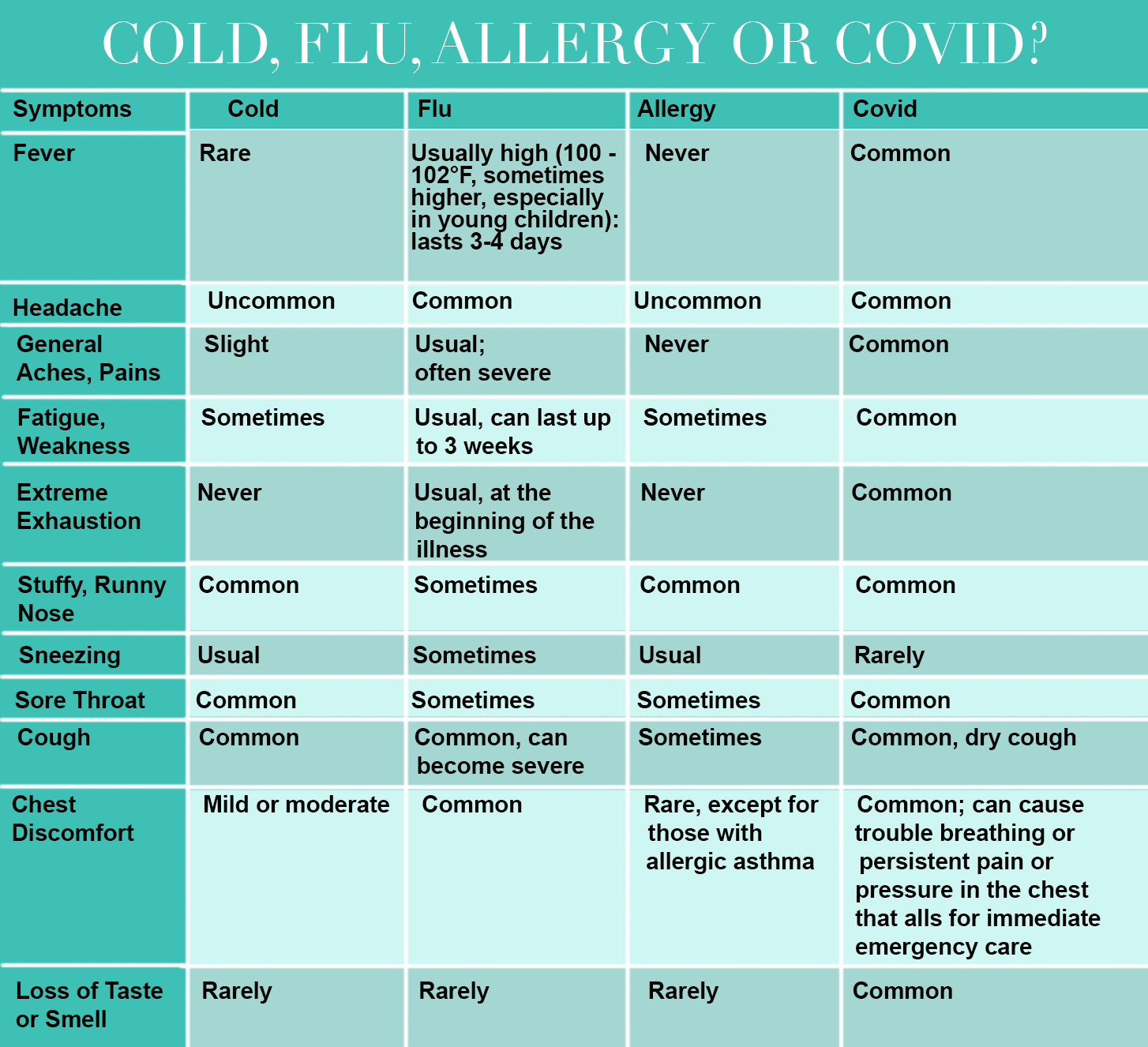Now that the winter is coming to an end, suddenly your child is sneezing, coughing, has a stuffy head, fever, body aches… what is causing all those symptoms?

Don’t let the symptoms fool you
The list of respiratory symptoms in children is long and sometimes it’s difficult to tell the difference between colds, allergies, flu, Covid, and asthma. We’re here to help you figure it out. (Please check with your child’s pediatrician before administering medicine or implementing a treatment plan.)
Although your child’s symptoms may be confusing, there are some definite parameters for various conditions and illnesses, so read on!
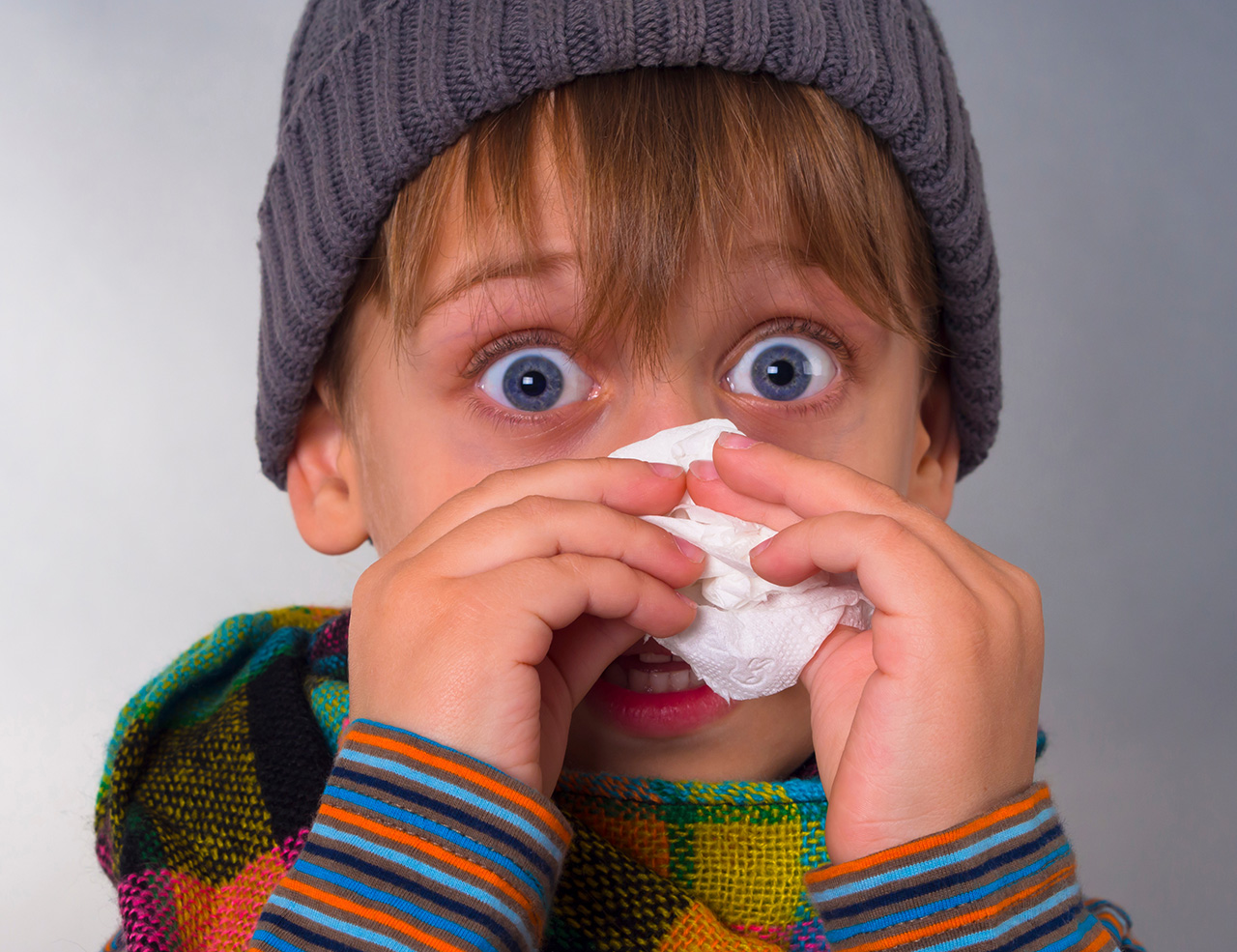
Is it a common cold?
And actually, what is a “common cold”? According to Stamford Medicine, this upper respiratory infection is among the most common illnesses in children. In fact, it tops the list in leading causes of healthcare provider visits and missed school days. Millions of people in the United States will catch a cold every year.
It’s worse among children than it is among adults. Most kids will have at least six to eight colds each year. If your child is in daycare, he will have even more. Most of the time, these infections will occur during the fall and winter.
What causes the common cold in children?
Colds occur when a virus irritates the lining of the nose and throat. There are more than 200 different viruses that can cause a cold in your child. Here is a list of the most frequent ones.
- Rhinovirus. This bunch is most active in early fall, spring, and summer. They cause 10%-40% of colds. You’ll feel plenty miserable when you catch one, but the good news is they rarely make you seriously sick.
- Coronavirus. These tend to do their dirty work in the winter and early spring. The coronavirus is the cause of about 20% of colds. There are more than 30 kinds, but only three or four affect people.
- RSV and parainfluenza. These viruses cause 20% of colds. They sometimes lead to severe infections, like pneumonia, in young children.
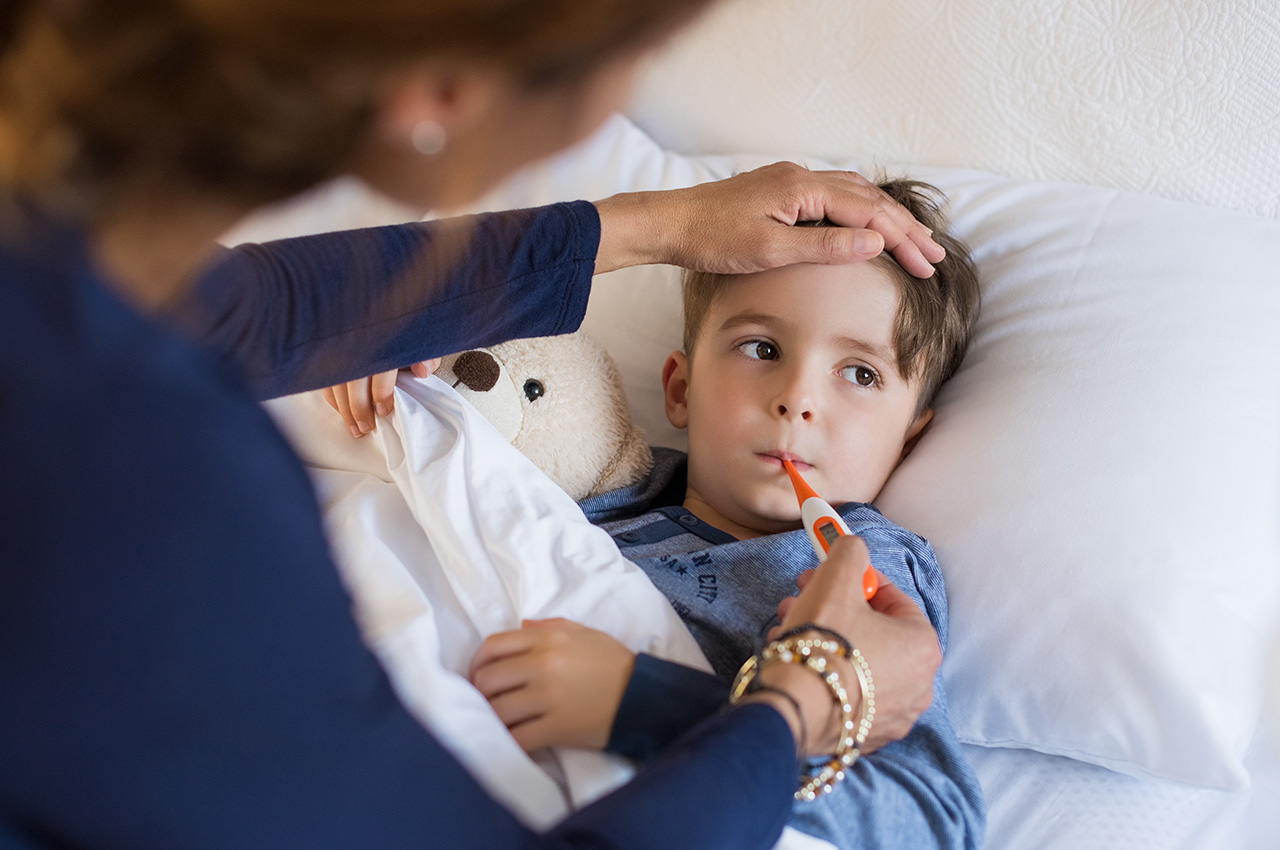
How do children catch a cold?
In order to catch a cold, your child must come in contact with someone who has a cold infection. Here’s how most colds are spread.
- Through the air. Coughing and sneezing releases small amounts of the virus which can go into the air. Breathing in that air can transfer the virus to the membranes of your child’s nose.
- By direct contact. Children are notorious for frequently touching their noses, mouths, and eyes, the places where cold viruses are present, and then they touch other kids, toys, surfaces…
Is your child at risk?
All children are at risk for the common cold. Children are more likely than adults to get colds, and here’s why.
- Children have less resistance because their immune systems are not as strong as an adult’s.
- In the winter, children are inside more and around more germs. Low humidity also causes the passages in their noses to become drier, more at greater risk for infection.
- In school or daycare, children are in close contact with others who might be harboring the illness.
- Kids don’t wash their hands nearly enough, even though they touch their faces more. The most common way that germs are spread is through germs on hands from touching eyes, noses, and mouths.
What are the symptoms of the common cold in a child?
Symptoms of the common cold show up from 1 to 3 days after exposure and normally last about a week. However, each child is different so some children may be symptomatic for 10 days to 2 weeks. Here’s what a cold looks like.
In babies, cold symptoms may include:
- Trouble sleeping
- Fussiness
- Congestion in the nose
- Sometimes vomiting and diarrhea
- Fever
Older children may have:
- Stuffy, runny nose
- Scratchy, tickly throat
- Watery eyes
- Sneezing
- Mild hacking cough
- Congestion
- Sore throat
- Achy muscles and bones
- Headaches
- Low-grade fever
- Chills
- Watery discharge from the nose that thickens and turns yellow or green
- Extreme tiredness (fatigue)
These symptoms may seem like other health problems, such as the flu. Make sure your child sees his or her healthcare provider for a diagnosis.

Is it the flu?
Influenza (flu) is a very contagious viral infection that attacks the air passages of the lungs. Flu is among the most common and severe viruses that generally is experienced during the winter season. Although most children recover within a week, some infections are so serious that they require hospitalization. Flu can lead to lung infection (pneumonia) or even death.
What causes the flu in children?
There are three types of flu viruses, called types A, B, and C. Types A and B cause widespread illness (epidemics) nearly every year in the winter. These two types lead to more hospitalizations and deaths than does type C. Influenza type C is very mild and rarely causes epidemics or the severe public health impact than do types A and B.
How do children catch the flu?
Influenza is passed from one child to another through sneezing and coughing. It can live for a short time on surfaces, which makes doorknobs, toys, pens and pencils, keyboards, phones, and even countertops a “flu factory” for spreading the illness. Sharing eating utensils or cups, bottles, and glasses can also spread flu. As with the common cold, because children frequently touch their eyes, noses, and mouths, daycare is a leading place for children to catch flu. Since people are most contagious with the flu 24 hours before symptoms start and again while symptoms are at their worst, your child may be exposed even when it looks like no one at the daycare is sick. However, contagion usually wanes by day seven.
Is your child at risk?
Your child is most a risk of catching the flu if he or she:
- Is around other people with the flu
- Is unvaccinated for the flu
- Doesn’t wash hands after touching infected surfaces
Young children and those with underlying health conditions may be at greater risk for hospitalization or severe or complicated influenza infection.
What are the symptoms of the flu in children?
Even though influenza is a respiratory illness, symptoms may affect the whole body. Your child can suddenly become ill with only a few or all of the symptoms below.
- Fever, which may be as high as 103°F (39.4°C) to 105°F (40.5°C)
- Body aches, which may be severe
- Headache
- Sore throat
- Cough that gets worse
- Tiredness
- Runny or stuffy nose
- Nausea
- Vomiting
- Diarrhea
Although most children recover from the flu inside a week, they may feel fatigued for as long as 3 to 4 weeks after recovering.
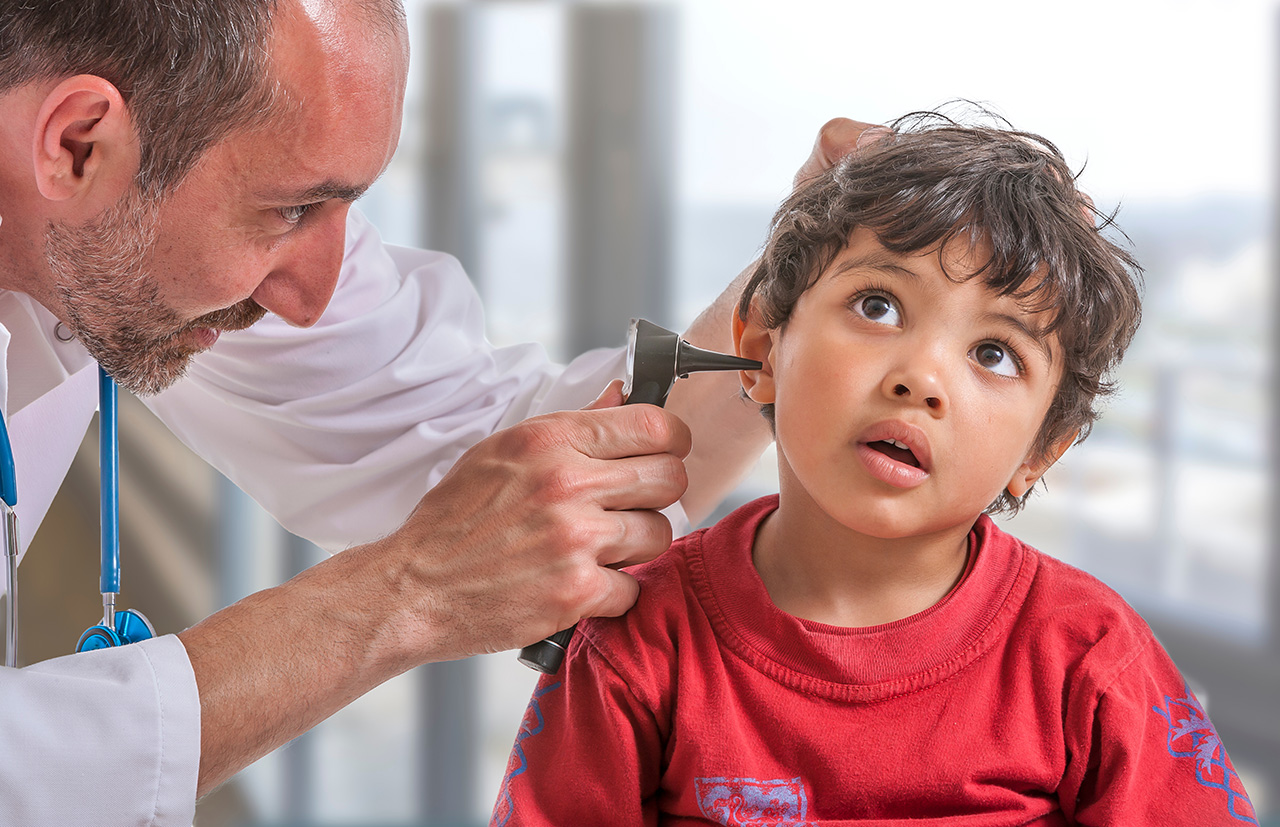
Comparison of flu and cold symptoms
| Cold symptoms | Flu symptoms |
| Low or no fever | High fever |
| Sometimes a headache | Headache in most cases |
| Stuffy, runny nose | Clear nose, or stuffy nose in some cases |
| Sneezing | Sneezing in some cases |
| Mild, hacking cough | Cough, often turning severe |
| Mild body aches | Severe body aches |
| Mild tiredness | Extreme tiredness that can last weeks |
| Sore throat | Sore throat in some cases |
Most colds are mild and resolve within a few days. Influenza can cause severe symptoms and lead to pneumonia or death.
Is it an allergy?
Allergies are not illnesses, but problems of the immune system. However, because they can often look like illnesses, we are including them here.
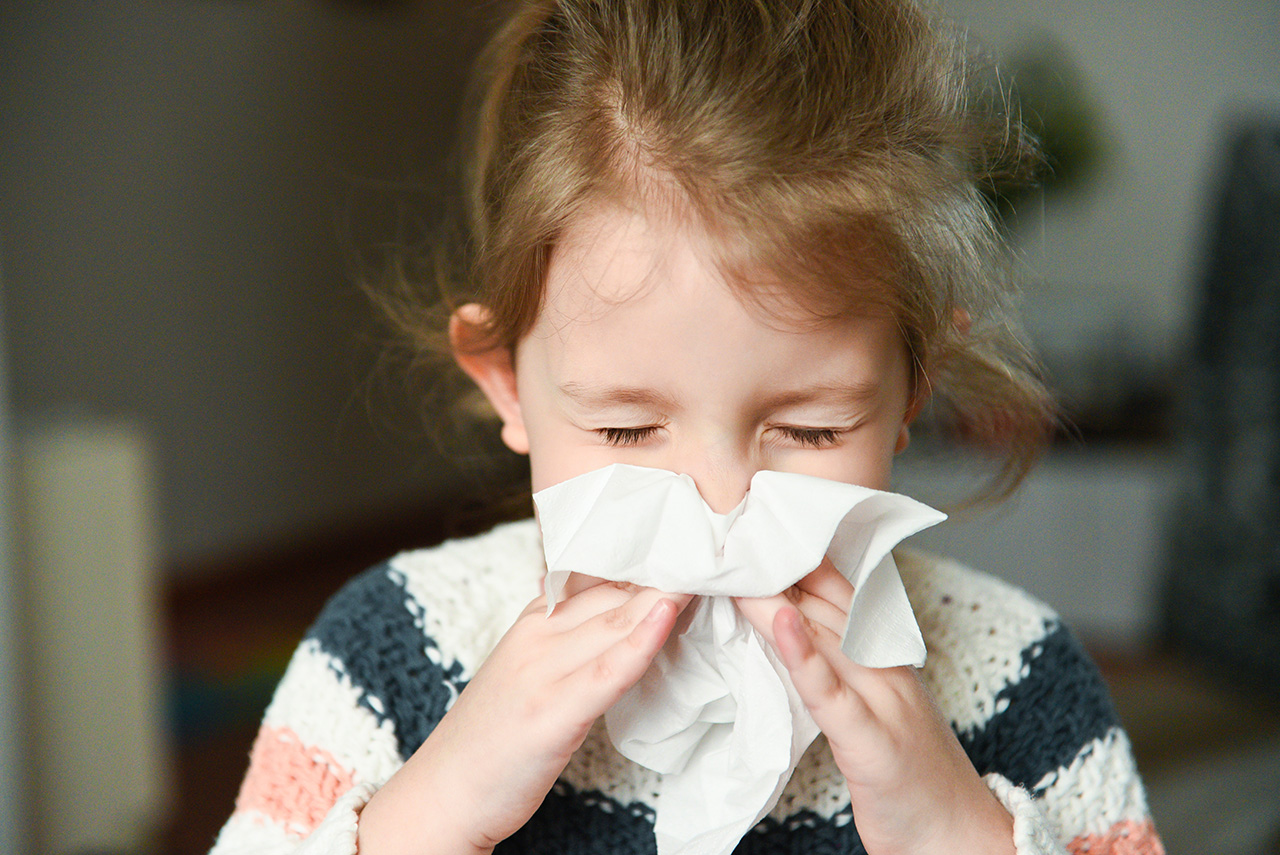
What causes allergies in children?
Most allergic reactions are when the immune system reacts to a “false alarm.” It is an over-reaction to normally mild things, such as dust, mold, or pollen. Normally, allergens are harmless. But children with allergies have immune systems that “think” they are harmful. When this happens, the body attacks allergens with antibodies called immunoglobulin E (IgE). Special cells called mast cells have these antibodies attached. The allergens stick to the antibodies, releasing histamine and other chemicals that cause an allergic reaction. If the chemicals irritate nasal tissue, nasal allergy symptoms result. If it happens in the lungs’ breathing tubes, it can cause asthma symptoms such as coughing and wheezing. A severe allergic reaction occurs when the whole body is affected.
Many things can trigger allergic reactions. But the most common triggers or allergens are:
- Tree, grass, and weed pollens
- Natural rubber latex
- Molds
- Dust mites
- Animal dander, urine, and oil from skin
- Foods
- Medicines
- Feathers
- Bee stings
- Pests such as cockroaches and mice
Is your child at risk?
Anyone can have allergies, regardless of age, gender, race, or socioeconomic status. Allergies are more common in children generally, but they can occur at any age. Even if allergies are in remission for many years, they can still return. Allergies tend to run in families, but medical science is still trying to understand why.
What are allergy symptoms in a child?
Although allergy symptoms often happen slowly over time, they can show up literally anywhere in the body. Places such as skin, eyes, lining of the stomach, nose, sinuses, throat and lungs, where immune system cells are located to fight off germs breathed in, swallowed, or come in contact with the skin, are where symptoms show up.
Allergic reactions can cause:
- Stuffy nose, sneezing, itching, or runny nose, and itching in ears or roof of mouth
- Red, itchy, watery eyes
- Red, itchy, dry skin
- Hives or itchy welts
- Itchy rash
- Asthma symptoms, such as shortness of breath, coughing, wheezing
- A severe, life-threatening allergic reaction (anaphylaxis). This can cause trouble breathing, vomiting, diarrhea, low blood pressure, fainting, or death.
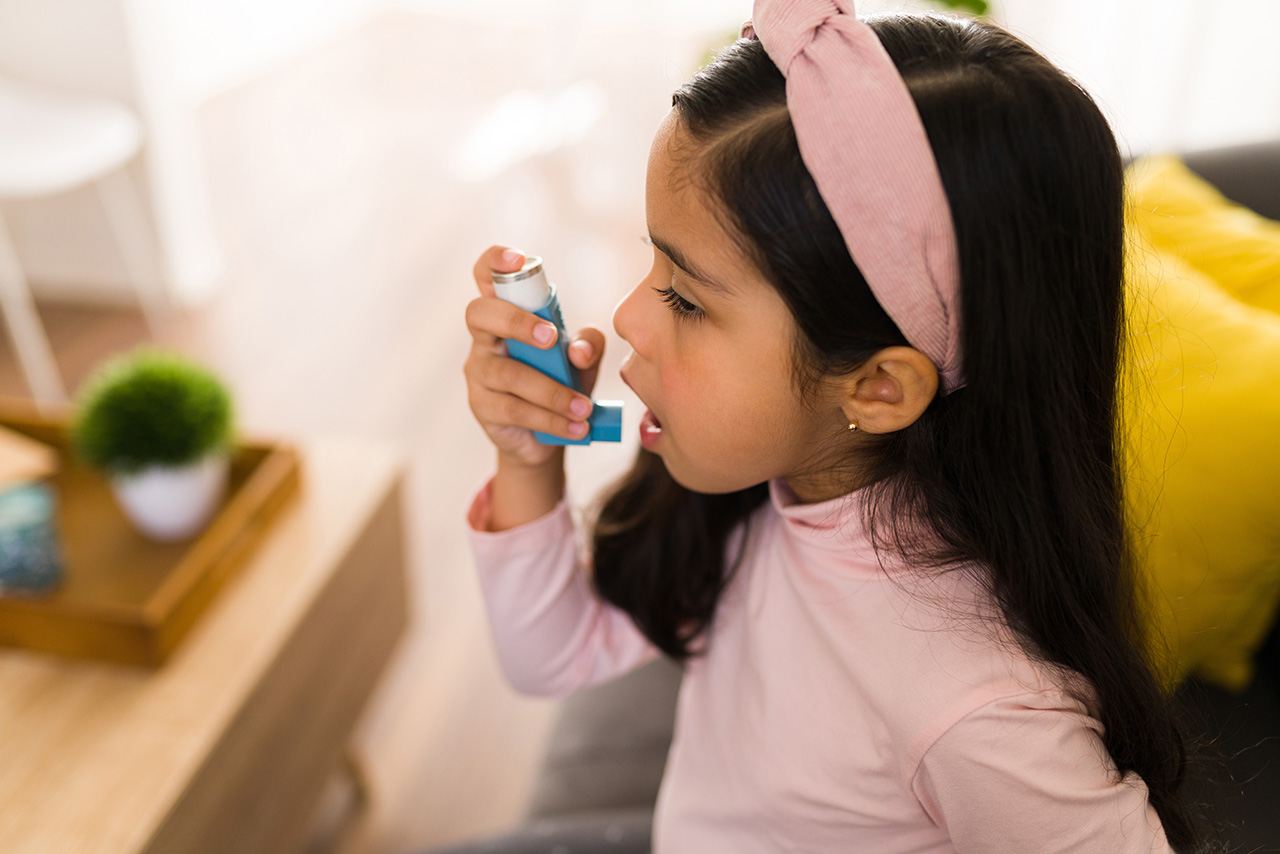
Is it Asthma?
Asthma is a chronic (long-term) lung disease. It causes your child’s airways to be sensitive to triggers, which causes the airways to do several things.
- The lining around the airways swells
- The muscles around the airways tighten
- The airways make more thick mucus than normal
- This makes the airways narrow
- Which makes it difficult for air to go into and out of the child’s lungs
What causes asthma in children?
This is a mystery that medical science hasn’t solved yet. Environment, infections, chemicals and even genetics can cause asthma.
Is your child at risk?
There are several risk factors that may lead to asthma in your child.
- Family members with asthma
- Environmental allergies, food allergies, or eczema
- Tobacco smoke in the home
- Air pollution
- Another health problem such as sinus problems or extra weight
What are asthma symptoms in a child?
Different children will experience the symptoms of asthma differently. Sometimes an asthmatic child may have few or no symptoms. Other times symptoms may flare up and cause:
- Cough that is either constant or comes and goes
- Wheezing or whistling sound that is heard while your child is breathing
- Trouble breathing or shortness of breath while your child is active
- Chest tightness
- Tiredness
- Cough at night
- Noisy breathing
What are asthma symptoms in a child?
Different children will experience the symptoms of asthma differently. Sometimes an asthmatic child may have few or no symptoms. Other times symptoms may flare up and cause:
- Cough that is either constant or comes and goes
- Wheezing or whistling sound that is heard while your child is breathing
- Trouble breathing or shortness of breath while your child is active
- Chest tightness
- Tiredness
- Cough at night
- Noisy breathing
Unfortunately, the symptoms of asthma may look like other health conditions. Your child should see his or her pediatrician for a diagnosis, because asthma that is not well controlled can cause:
- Severe attacks that can lead to hospitalization or even death
- Lasting damage to the airways
- Increased time in the hospital or the emergency department
- Missed school or other activities
Symptoms that indicate an emergency are the following.
- Trouble breathing
- Trouble sleeping
- Trouble walking
- Trouble talking
- Coughing that won’t quit
- Wheezing when breathing in and out
- Wheezing that gets worse after medicine should be working (most quick-relief medicines work within 15 minutes)
- Feeling faint, dizzy, or weak
Call 911 if your child has any of these:
- Lips or nails are turning blue
- Nostrils flare each time he or she inhales
- Can’t talk or walk at a normal pace
- Rapid breathing (30 or more breaths per minute)

Is it COVID-19?
People of all ages can get the coronavirus disease. Children can get it and experience its complications as well as adults.
Is your child at risk?
Children with COVID-19 represent about 19% of all COVID-19 cases in the United States. Children are less likely than adults to become severely ill, and up to 50% of children could haveCOVID-19 without any symptoms. However, some children who catch the disease may need to be hospitalized. Certain medical conditions may increase a child’s risk of serious illness with COVID-19, including:
- Obesity
- Diabetes
- Asthma
- Congenital heart disease
- Genetic conditions
- Conditions affecting the nervous system or metabolism
Very young children (under the age of 1 year) might be at higher risk for COVID-19 than older children.
What are COVID-19 symptoms in a child?
Children with COVID-19 can have a lot of symptoms or none at all. The top two symptoms in children are cough and fever, but there are others:
- Fever
- Cough that becomes productive
- Chest pain
- New loss of taste or smell
- Changes in the skin, such as discolored areas on the feet and hands
- Sore throat
- Nausea, vomiting, belly pain or diarrhea
- Chills
- Muscle aches and pain
- Extreme fatigue
- New severe headache
- New nasal congestion
Symptoms of COVID-19 on average appear about 6 days after exposure to the illness. As the symptoms of COVID-19 might be similar to other illnesses such as the flu or allergies, take your child to the physician if any of these appear. Due to the complications that may occur with COVID-19, it is imperative to see a pediatrician if you suspect your child may have been exposed. For more information on COVID-19 in children, visit COVID-19 in Children and Infants by Mayo Clinic.
